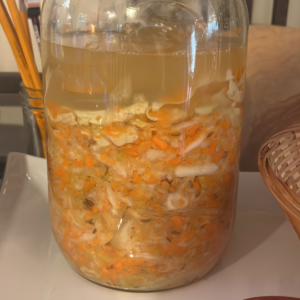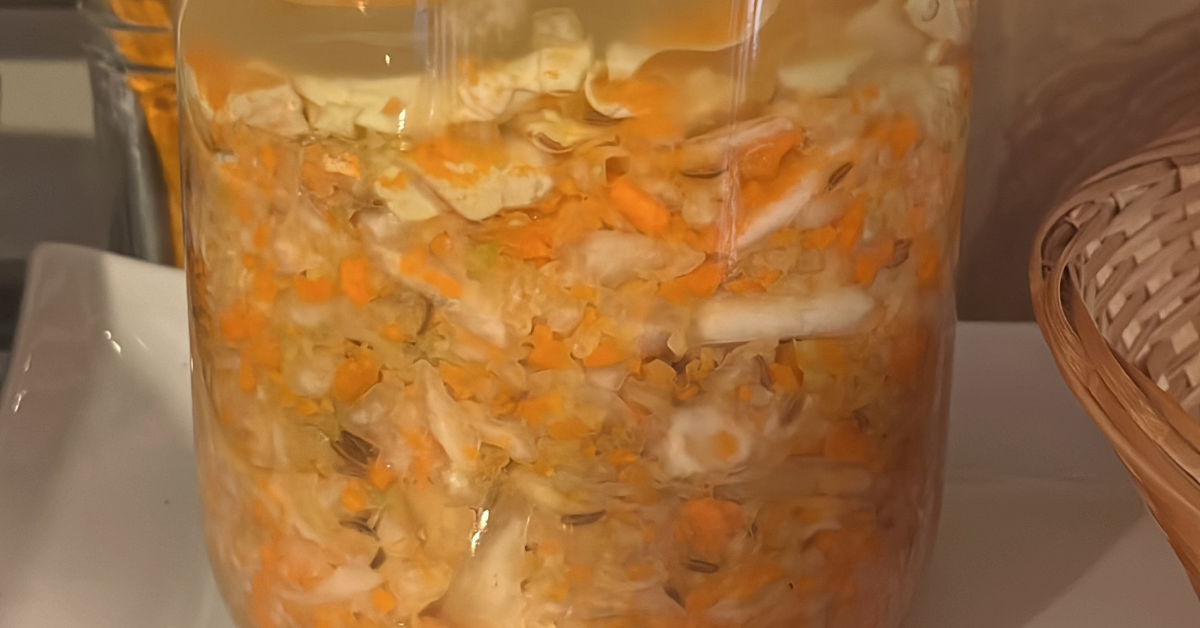Learn how to make sauerkraut with these easy step by step instructions. Sauerkraut is a superfood (my opinion) with a ton of health benefits. It's not just something you put on top of a hot dog, it is so much more. Sauerkraut is essentially fermented cabbage, along with other optional veggies. It contains the friendly probiotic bacteria your body needs for healthy digestion and strong immune function.
Health Benefits of Sauerkraut
Cabbage alone is cruciferous vegetable high in vitamins A and C. Studies have shown that cruciferous vegetables can help lower cholesterol levels and combat cancer. Additionally, cabbage is a rich source of phytonutrient antioxidants and has anti-inflammatory properties. Fermenting cabbage to make sauerkraut amplifies the health benefits and makes this a superfood.
Probiotics in Sauerkraut
Healthy human colons contain many beneficial bacteria that break down the foods that we eat. Without these beneficial bacteria the human digestive system is at risk to harmful parasites and yeasts which can result in the condition of candida. Sauerkraut provides a high density source of a wide range of beneficial live bacteria which assist in the digestive process.
Consuming a serving of sauerkraut can give your body as much of a health boost as many of the expensive probiotic supplements sold in stores. However, most commercially sold sauerkraut have lost most of their beneficial bacterial organisms due to processing or pasteurization. To obtain the most benefits from sauerkraut it's best to purchase it freshly made (unheated and unpasteurized), or learn how to make your own. It is a simple process to make sauerkraut therefore you can make it at home very easily.
Ingredients for Homemade Sauerkraut
There are really only two required ingredients:
- Cabbage
- Salt
Most people add some other ingredients for more flavor. Some vegetable and herb additions that some people use include:
- Apples
- Carrots
- Caraway seeds
- Turmeric
- Horseradish
- Hot peppers
- Garlic cloves
- Ginger
- Dill
- Fennel
- Beets
- Lemon
You can be creative and make your own combinations. I suggest you start with a very basic recipe the first time and then try different additions one by one until you find your favorite custom recipe.
What Kitchen equipment is needed?
You will need the following items:
- A glass jar – an airlock jar or fermenting crock is ideal but a regular mason jar will work.
- Glass fermentation weights
- A wooden fermentation tamper or spoon
How Much Salt do you Use in Sauerkraut?
The most widely used ratio is 2% weight of salt to weight of cabbage gives the best results. This means you add 2g of salt for every 100g of finely sliced cabbage. For reference, 1 tbsp. of salt weighs about 18 grams.

Homemade Sauerkraut
Equipment
- Mason jar, Airlock jar, or Fermentation Crock
- Glass fermentation weights optional, but helpful
Ingredients
- 1 head Cabbage red and/or green, shredded
- 2-4 Carrots grated
- 1 Apple grated
- 1 tbsp Caraway seeds optional
- 1-2 tbsp Sea salt
Instructions
- Shred cabbage into thin strips and put it into a large bowl. Save the outside leaves to use in the last step.
- Grate carrots and apple and add to the bowl. You can also add other vegetables if you wish. Add caraway seeds, if using.
- Weigh the vegetables to calculate salt amount needed (2% salt). Sprinkle salt on the shredded cabbage.
- Toss the cabbage to distribute the salt. Now comes the work, using your hands knead the cabbage like you would knead bread.
- Mix the cabbage and press down with the palm of your hands and squeeze out the juice of the cabbage. Do this for a few minutes until the cabbage looks a little broken down and juicy. If it is not that juicy, let it sit for 15-60 minutes.
- Spoon the cabbage mixture into a large glass jar or a fermentation crock and press down with a wooden spoon.
- The vegetables need to be completely covered in liquid. In order to do that it needs to be weighed down so that there is a little pressure on it.
- Place the outside cabbage leaves you reserved in step one on top of the shredded cabbage. This helps to keep it down under the liquid. If there is not enough liquid, you can add some water.
- Place glass fermentation weights on top of the vegetables and push down so the liquid rises. If you don't have weights use a ziplock bag of water as a weight. Insert an empty plastic bag into the jar with the opening of the bag outside the top of the jar and fill with water. Close up the bag and press down gently to release any air and then close the jar.
- Leave the jar alone to ferment for a minimum of 5 -21 days.
- If you are using a mason jar without an airlock open the jar once a day to let out some air.
- The longer you let the cabbage ferment the more different types of probiotics will form and it will taste stronger the longer it ferments. The time frame you could let it ferment is 5 to 30 days. Once you are done fermenting, removed the weights and whole cabbage leaves (discard) and spoon the sauerkraut into smaller jars and refrigerate.
Once you get the hang of it making sauerkraut is fun and easy. You can also make your own variations of this recipe by adding different vegetables. If you want to try more fermenting recipes, visit our fermenting page here.
Thank you for reading this post, don't forget to subscribe to stay in the loop. If you are looking for some of the healthy tools and resources mentioned in my articles, take a look at my healthy shopping guide.
Some of our links are affiliate links, which means if you click and buy, I earn a small commission. The price is the same for you, though. Thank you!
You might also like these posts...

